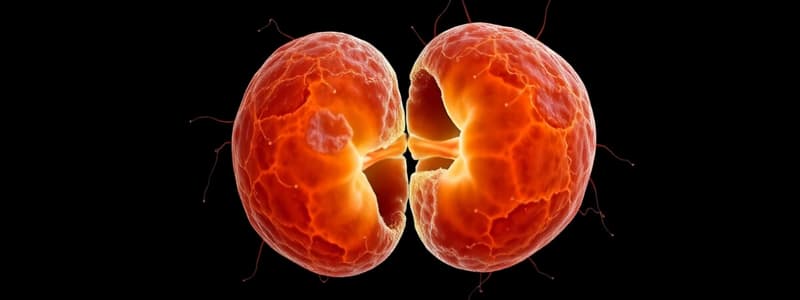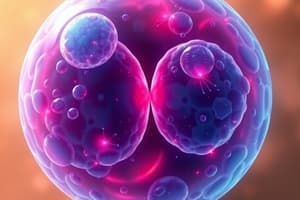Podcast
Questions and Answers
Which part of the brain is responsible for coordinating movement and balance?
Which part of the brain is responsible for coordinating movement and balance?
- Cerebellum (correct)
- Corpus callosum
- Cerebrum
- Brainstem
What is a major ethical concern surrounding the use of embryonic stem cells?
What is a major ethical concern surrounding the use of embryonic stem cells?
- The limited potential of embryonic stem cells to differentiate into various cell types
- The lack of availability of adult stem cells
- The difficulty in isolating and culturing embryonic stem cells
- The potential for misuse and improper research practices (correct)
Which of the following is NOT a function of the brainstem?
Which of the following is NOT a function of the brainstem?
- Controlling heart rate
- Coordinating voluntary movements (correct)
- Processing sensory information
- Regulating breathing
What is a key characteristic of stem cells that makes them valuable in medical research?
What is a key characteristic of stem cells that makes them valuable in medical research?
Which of the following is a potential benefit of stem cell research?
Which of the following is a potential benefit of stem cell research?
During which phase of mitosis do sister chromatids separate and move to opposite poles of the cell?
During which phase of mitosis do sister chromatids separate and move to opposite poles of the cell?
Which structure in the eye is responsible for regulating the amount of light entering?
Which structure in the eye is responsible for regulating the amount of light entering?
What is the function of the central nervous system (CNS)?
What is the function of the central nervous system (CNS)?
Which type of neuron transmits signals from the sensory organs to the CNS?
Which type of neuron transmits signals from the sensory organs to the CNS?
Which of the following is NOT a function of mitosis?
Which of the following is NOT a function of mitosis?
What is the role of the lens in the eye?
What is the role of the lens in the eye?
Which component of the brain is responsible for coordinating movement and balance?
Which component of the brain is responsible for coordinating movement and balance?
Which of the following is a major ethical concern surrounding the use of stem cells for therapeutic purposes?
Which of the following is a major ethical concern surrounding the use of stem cells for therapeutic purposes?
Flashcards
Mitosis
Mitosis
A type of cell division resulting in two identical daughter cells.
Phases of Mitosis
Phases of Mitosis
The stages include prophase, metaphase, anaphase, and telophase.
Prophase
Prophase
Chromosomes condense, nuclear envelope breaks down, spindle fibers form.
Metaphase
Metaphase
Signup and view all the flashcards
Anaphase
Anaphase
Signup and view all the flashcards
Telophase
Telophase
Signup and view all the flashcards
Cytokinesis
Cytokinesis
Signup and view all the flashcards
Human Eye
Human Eye
Signup and view all the flashcards
Cerebrum
Cerebrum
Signup and view all the flashcards
Cerebellum
Cerebellum
Signup and view all the flashcards
Brainstem
Brainstem
Signup and view all the flashcards
Embryonic Stem Cells
Embryonic Stem Cells
Signup and view all the flashcards
Informed Consent
Informed Consent
Signup and view all the flashcards
Study Notes
Mitosis
- Mitosis is a type of cell division producing two identical daughter cells.
- Essential for growth, repair, and asexual reproduction.
- Phases include prophase, metaphase, anaphase, and telophase.
- Prophase: Chromosomes condense, the nuclear envelope breaks down, and spindle fibers form.
- Metaphase: Chromosomes align at the metaphase plate.
- Anaphase: Sister chromatids separate and move to opposite poles.
- Telophase: Chromosomes decondense, nuclear envelopes reform, and the cell divides.
- Cytokinesis divides the cytoplasm, completing the process.
- Critical for organismal growth, tissue repair, cell replacement, and asexual reproduction.
Eyes
- The human eye is a complex sensory organ for vision.
- Light enters through the cornea, which refracts the light.
- The iris adjusts the amount of light entering the eye.
- The lens further refracts light, focusing it onto the retina.
- The retina contains photoreceptor cells (rods and cones) converting light to electrical signals.
- Rods enable low-light and peripheral vision.
- Cones are for color vision and high-resolution vision.
- The optic nerve transmits electrical signals from the retina to the brain.
Nervous System
- The nervous system is the body's communication network.
- Composed of the central nervous system (CNS) and the peripheral nervous system (PNS).
- The CNS includes the brain and spinal cord.
- The PNS consists of nerves branching from the CNS, connecting to the body.
- Neurons are the nervous system's functional units.
- Neurons transmit information via electrical and chemical signals.
- Neurotransmitters carry signals across synapses (gaps between neurons).
- Sensory neurons carry signals from the environment to the CNS.
- Motor neurons carry signals from the CNS to muscles and glands.
- Interneurons connect sensory and motor neurons within the CNS.
Structure of the Brain
- The brain is the body's control center.
- It receives, processes, and sends information throughout the body.
- Key structures include the cerebrum, cerebellum, and brainstem.
- Cerebrum: Higher-level functions like thought, memory, and language. Divided into two hemispheres connected by the corpus callosum.
- Cerebellum: Coordinates movement and balance.
- Brainstem: Controls essential life functions like breathing and heart rate.
- Different brain regions have specialized roles.
Ethical Issues Surrounding the Use of Stem Cells
- Stem cells are undifferentiated cells, becoming various cell types.
- Embryonic stem cells come from embryos.
- Adult stem cells are found in various body tissues.
- Ethical concerns surround embryonic stem cell research, especially extraction methods and using human embryos.
- Potential for treating diseases, especially regenerative medicine.
- Religious and moral views can oppose embryonic stem cell research.
- Potential for misuse and irresponsible practices in stem cell research.
- Importance of informed consent for stem cell research.
- Debate about allocating resources to stem cell research relative to other medical needs.
Studying That Suits You
Use AI to generate personalized quizzes and flashcards to suit your learning preferences.




